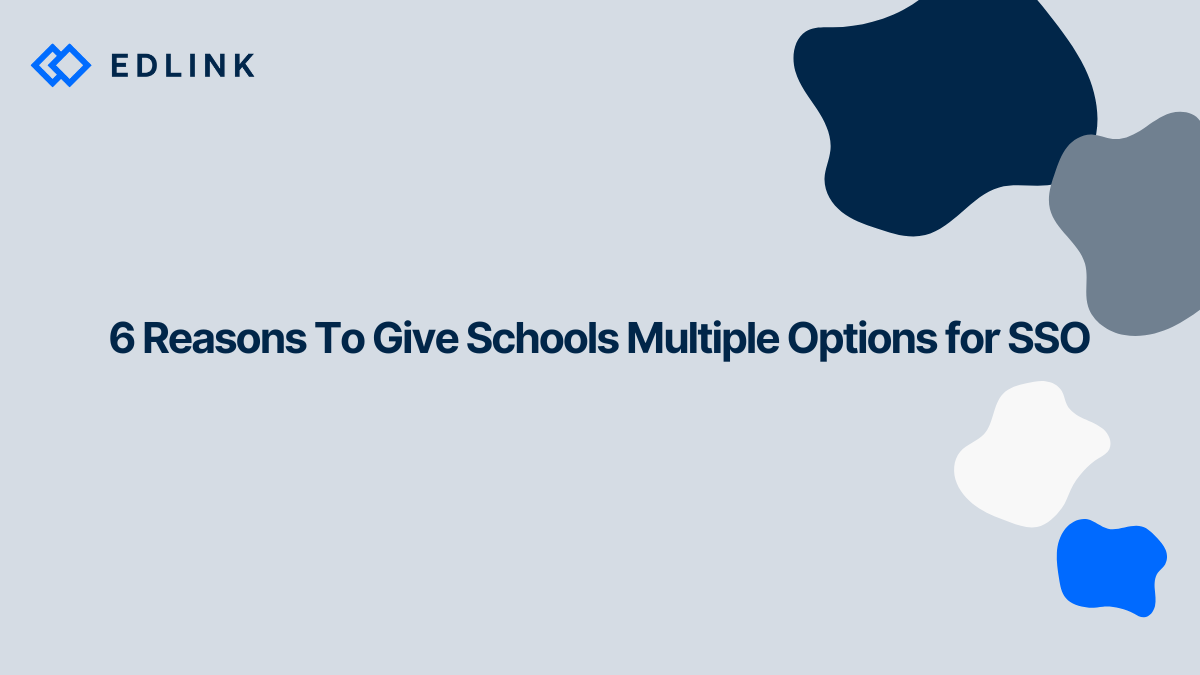Nearly every website you visit today offers you a way to sign-in using an account that you've created elsewhere. When you're creating an account on a new website, how often do you select Sign in with Facebook or Sign in with Google instead of actually entering an entirely new username and password? Pretty frequently, right? You don't want to have to remember different credentials for each website you use. You want to get started as quickly as possible. So do your schools.
School IT admins don't want their teachers - and especially their students - to have to remember different usernames and passwords for each digital product they use. They want their teachers and students to be able to sign into any product the school uses with the credentials they already use for other platforms. Products that allow authentication through a third-party provider support SSO: single-sign on.
Since we're dealing with schools and not your average Joe, your edtech app needs to take a different approach to SSO. Just supporting a single method of logging in teachers and student won't cut it. As you'll discover, supporting many schools means supporting many different SSO options.
Here are six reasons why you need to give schools multiple options for SSO.
1. Schools use a ton of different platforms...and in different ways.
Schools across the country use a variety of learning management systems (e.g. Google Classroom, Moodle, Blackboard) student information systems (e.g. PowerSchool, Skyward, Infinite Campus), and roster management providers (e.g. Clever, Classlink) to manage their teachers and students. No one vendor has a monopoly on any of these markets. This means that many of the schools you work with will very likely require different SSO integrations.
Keep in mind that you'll also need to be able to handle different types of SSO logins from the same platform. For example, LMS's like Schoology and Canvas can be configured to authenticate users through another third-party service, like Google. Knowing how to deal with these situations is key to making sure that your SSO integrations work properly for any school that comes your way.
2. SSO is the first step to developing deeper integrations.
Implementing SSO into your app will open new possibilities that go beyond simply getting users signed in. Most LMS's provide integrations that allow external applications the ability to act on behalf of their authenticated users.
For example, let's say you have teachers who can authenticate via their Schoology account. You could then use the Schoology API to retrieve a list of their courses or to let them create assignments in Schoology from your app.
Just by supporting SSO across different platforms, you'll be ahead of the game when schools come to you asking you for deeper integrations down the road.
3. SSO protects student identities.
When you implement SSO, you are no longer responsible for maintaining data such as passwords. While you are still on the hook for protecting student data, such as names and email addresses, the use of SSO cuts down on the amount of personally identifiable information (PII) you need to store.
Additionally, most LMS's support secure authentication protocols like OAuth 2. Since this is built into most SSO flows, you can rely on the platforms that your schools use to exchange teacher and student data securely.
In many cases, you'll have to work with school admins in order to allow their teachers and students to enable SSO for their campus. Working alongside the admins can make them and their teachers more comfortable with how your product handles student data.
4. SSO makes onboarding easier.
Getting signed in initially is the place where you have the most user attrition. People are easily frustrated by complicated sign-on flows. Teachers don't want to waste valuable class time getting their students signed into the app.
With SSO, teachers and students don't need to remember a new set of credentials. Furthermore, developers don't need users to fill in additional information upfront (e.g. their name, their role, their profile picture, what school their from, etc.) in order to setup their account.
5. SSO saves developers time.
Implementing multiple SSO options saves developers from several headaches down the road. If you develop your own sign-on flow, you have to write a secure username and password system. This will include developing tools to reset passwords and to ensure that passwords aren't easily broken. You also have to create admin tools so whoever manages the school's accounts can reset passwords.
Instead of developing these tools yourself, you can use SSO to do all of the heavy lifting. You don't have to save passwords or develop methods to help admins reset passwords when you support SSO. The user's main platform (e.g. the LMS or SIS) will control those aspects of user management. This means that you receive fewer ongoing support requests and you can spend more time focusing on your product.
Developing multiple SSO options will ensure that you are prepared for any school that will need an SSO integration. Once SSO options are properly implemented in your app, you won't have to develop new sign-on integrations for clients no matter which data platform they use.
6. It's what schools want!
Schools are tired of having to manage user accounts across different platforms. Teachers and students don't want to have to remember different sets of passwords and usernames each time they want to log into another app. These users are much more likely to use your app if they don't have to jump through hoops just to get online.
And lastly, SSO integration is a must-have for many school districts and is commonly requested in RFPs. Having an SSO integration pre-built will give you a leg up in convincing schools to work with you. For example, vendors working with Los Angeles USD have to support integration with Schoology, Clever, and/or GG4L. If you already support these platforms, you'll be a step closer to winning new contracts.
Bringing It All Together
Implementing different SSO solutions for your clients can keep you a step ahead of your competitors. While actually developing the SSO integrations can be a challenge, it's certainly worthwhile in order to win over new clients that need them.
Read More on Single Sign-On
Here are other articles we’ve written on SSO to help you on your integration journey:
- Why You Shouldn’t Match Users by Email Address Where SSO IS Involved
- How to Implement Single Sign-On with Canvas
- How to Implement Single Sign-On With Schoology
- How to Implement SSO with D2L Brightspace
- How to Implement SSO for Google Classroom
Want to Learn More about Edlink?
If you're looking for a partner who can help guide you through developing LMS integrations (like these), then let’s introduce ourselves. We’re Edlink!

